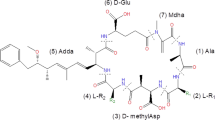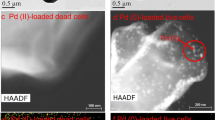Abstract
Microcalorimetric and biological methods were carried out to determine the toxicity of dimethylarsinic acid (DMA) and monomethylarsonic acid (MMA) to wild strain of Bacillus thuringiensis. Thermokinetic parameters were obtained from the power–time curves, showing that the peak-heat output power, total heat output, and number of colonies decreased with the increases in concentration of DMA and MMA. In addition, the generation time and peak maximal time increased with the increases in the dosage of DMA and MMA. The half inhibitory concentrations of DMA and MMA were 99.02 and 142.02 μg mL−1, respectively for the wild strain of B. thuringiensis. DMA shows higher toxicity to bacteria than MMA. The toxicity resistance of B. thuringiensis against organoarsenic(V) is quite high for the wild strain. Our work demonstrates that microcalorimetry is a very sensitive, simple, and useful technique for in vitro investigation of the toxic effect of organoarsenic(V) on microbial activity.





Similar content being viewed by others
References
Cullen WR , Reimer KJ (1989) Arsenic speciation in the environment. Chem Rev 89:713–764.
Smedley PL, Kinniburg DG (2002) A review of the source, behavior and distribution of arsenic in natural waters. Appl Geochem 17:517–568.
United States Environmental Protection Agency (1998), Locating and estimating air emissions from sources of arsenic and arsenic compounds EPA-454-R98-013, Office of Air Quality Planning and Standards.
Karagas MR, Le CX, Morris S, Blum J, Lu X, Spate V (2001) Markers of low level Arsenic exposure for evaluating human cancer risks in the US population. Int J Occup Env Heal 14:171–175.
Hughes MF (2002) Arsenic toxicity and potential mechanisms of action. Toxicol Lett 133:1–16.
Bednar AJ, Garbarino JR, Ferrer I, Rutherford DW, Wershaw RL, Ranville JF, Wildeman TR (2003) Photodegradation of roxarsone in poultry litter leachates. Sci Total Environ 302:237–245.
Fulladosa E, Murat JC, Bollinger JC, Villaescusa I (2007) Adverse effects of organic arsenical compounds towards Vibrio fischeri bacteria. Sci Total Environ 377:207–213.
United States Environmental Protection Agency (2001) Fact sheet: drinking water standard for arsenic EPA-815-F-00-015, The Office of Ground Water and Drinking Water.
Agency for Toxic Substances and Disease Registry (2000), Toxicological profile for arsenic. United States Department of Health and Human Services, Public Health Service, Agency for toxic Substances and Disease Atlanta, Georgia, www.atsdr.cdc.gov/clist.html.
Ferguson JF, Gavis J (1972) A review of arsenic cycle in natural waters. Water Res 69:1259–1274.
Jain CK, Ali I (2000) Arsenic: occurrence, toxicity and speciation techniques. Water Res 34:4304–4312.
Prado AGS, Airoldi C (1999) The influence of moisture on microbial activity of soils. Thermochim Acta 332:71–74.
Zheng D, Liu Y, Zhang Y, Chen XJ, Shen YF (2006) Microcalorimetric investigation of the toxic action of Cr(VI) on the metabolism of Tetrahymena thermophila BF5 during growth. Environ Toxicol Phar 22:121–127.
Ma J, Qi WT, Yang LN, Yu WT, Xie YB, Wang W, Ma XJ, Xu F, Sun LX (2007) Microcalorimetric study on the growth and metabolism of microencapsulated microbial cell culture. J Microbiol Meth 68:172–177.
Miles RJ, Beezer AE, Lee DH (1986) Growth of mycoplasma mycoides subspecies mycoides on media containing various sugars and amino sugars: an ampoule microcalorimetric study. Microbios 45:7–19.
Fargašsová A (1994) Comparative toxicity of five chemicals on various biological subjects. Bull Environ Contam Toxicol 53:317–324.
Ghosh SK, Doctor PB, Kulkarni PK (1996) Toxicity of zinc in three microbial test systems. Environ Toxicol Water Qual 11:13–19.
Ribó JM, Yang JE, Huang PM(1989) Luminescent bacteria toxicity bioassay in the study of mercury speciation. Hydrobiologia 188/189:155–162.
Backman P, Bastos M, Briggner LE, Hägg S, Hallén D, Lönnbro P, Nilsson SO, Olofsson G, Schön A, Suurkuusk J, Teixeira C, Wadsö I, (1994) A system of microcalorimeters. Pure Appl Chem 66:375–382.
Prado AGS, Airoldi C (2001) Microcalorimetry of the degradation of the herbicide 2,4-D via the microbial population on a typical Brazilian red Latosol soil. Thermochim Acta 371:169–174.
Critter SAM, Freitas SS, Airoldi C, (2002) Comparison between microorganism counting and a calorimetric method applied to tropical soils. Thermochim Acta 394:133–144.
Critter SAM, Freitas SS, Airoldi C (2002) Microbial biomass and microcalorimetric methods in tropical soils. Thermochim Acta 394:145–154.
Angelika R, Ian AM, Janice ET (2007) Microbial community development in the rhizosphere of apple trees at a replant disease site. Soil Biol Biochem 39:1645–1654.
Lantz AE, Jørgensen P, Poulsen E, Lindemann C, Olsson L (2006) Determination of cell mass and polymyxin using multi-wavelength fluorescence. J Biotechnol 121:544–554.
Yao J, Tian L, Wang Y, Djah A, Wang F, Chen H, Su C, Zhuang R, Zhou Y, Choi MMF, Bramanti E (2008) Microcalorimetric study the toxic effect of hexavalent chromium on microbial activity of Wuhan brown sandy soil: an in vitro approach. Ecotox Environ Safe 69:289–295.
Wang J, Li S, Huang Z (2003) Environmental microbiology, High Education Press, Beijing, pp 311.
Chen CY, Liu Y, Zhou JY, Xu HB, Qu SS (1997) Microcalorimetric study of the toxic effect of selenium on the mitochondrial metabolism of Cyrinus carpio liver. Biol Trace Elem Res 60:115–163.
Thomas DJ, Styblo M, Lin S (2001) The cellular metabolism and systemic toxicity of arsenic. Toxicol Appl Pharm 176:127–144.
Ellenhorn MJ (1997) Ellenhorn’s Medical toxicology: diagnosis and treatment of human poisoning, second ed., Williams & Wilkins, Baltimore, p. 1540.
Endo G, Kuroda K, Okamoto A, Hiriguchi S (1992) Dimethylarsenic acid induces tetraploids in Chinese hamster cells. Bull. Environ Contam Toxicol 48:131–137.
Eguchi N, Kuroda K, Endo G (1997) Metabolites of arsenic induced tetraploids and mitotic arrest in cultured cells. Arch Environ Contam Toxicol 32:141–145.
Tezuka M, Hanioka K, Yamanaka K, Okada S (1993) Gene damage induced in human alveolar type II (L-132) cells by exposure to dimethylarsinic acid. Biochem Biophys Res Commun 191:1178–1183.
Yamanaka K, Hayashi H, Kato K, Hasegaw A, Okada S (1995) Involvement of preferential formation of apurinic/apyrimidinic sites in dimethylarsenic-induced DNA strand breaks and DNA-protein crosslinks in cultured alveolar epithelial cells. Biochem Biophys Res Commun 207:244–249.
Seike N, Wanibuchi H, Morimura K, Nishikawa T, Kishida H, Nakae D, Hirata K, Fukushima S (2002) Lack of promoting effect due to oral administration of dimethylarsinic acid on rat lung carcinogenesis initiated with N-bis(2-hydroxypropyl)nitrosamine. Cancer Lett 175:113–119.
Acknowledgments
This work was supported in part by grants from the Sino-Italian, Sino-German PPP, Sino-Hungarian, Sino-Slovenian Governmental International Scientific and Technological Cooperation Project (200625, 20063139, 2006294, and 2007203), National Natural Science Foundation of China (40425001 and 40673065), the Specialized Research Fund for the Doctoral Program of Higher Education (20060491508), the Key Project of Chinese Ministry of Education (107077), the Hubei Key International Cooperation Project (2006CA007), and 111 project (B08030).
Author information
Authors and Affiliations
Corresponding authors
Rights and permissions
About this article
Cite this article
Russel, M., Yao, J., Chen, H. et al. Biological and Microcalorimetric Studies of the Toxic Effect of Organoarsenic(V) Compounds to Wild Strain of Bacillus thuringiensis . Biol Trace Elem Res 131, 192–203 (2009). https://doi.org/10.1007/s12011-009-8358-1
Received:
Accepted:
Published:
Issue Date:
DOI: https://doi.org/10.1007/s12011-009-8358-1




